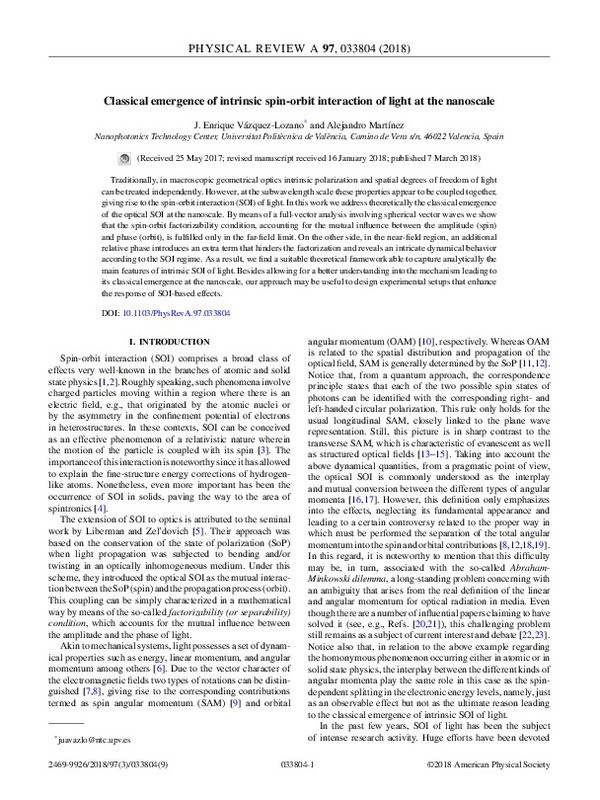JavaScript is disabled for your browser. Some features of this site may not work without it.
Buscar en RiuNet
Listar
Mi cuenta
Estadísticas
Ayuda RiuNet
Admin. UPV
Classical emergence of intrinsic spin-orbit interaction of light at the nanoscale
Mostrar el registro sencillo del ítem
Ficheros en el ítem
| dc.contributor.author | Vázquez-Lozano, Juan Enrique
|
es_ES |
| dc.contributor.author | Martínez Abietar, Alejandro José
|
es_ES |
| dc.date.accessioned | 2019-09-19T20:00:53Z | |
| dc.date.available | 2019-09-19T20:00:53Z | |
| dc.date.issued | 2018 | es_ES |
| dc.identifier.issn | 1050-2947 | es_ES |
| dc.identifier.uri | http://hdl.handle.net/10251/126100 | |
| dc.description.abstract | [EN] Traditionally, in macroscopic geometrical optics intrinsic polarization and spatial degrees of freedom of light can be treated independently. However, at the subwavelength scale these properties appear to be coupled together, giving rise to the spin-orbit interaction (SOI) of light. In this work we address theoretically the classical emergence of the optical SOI at the nanoscale. By means of a full-vector analysis involving spherical vector waves we show that the spin-orbit factorizability condition, accounting for the mutual influence between the amplitude (spin) and phase (orbit), is fulfilled only in the far-field limit. On the other side, in the near-field region, an additional relative phase introduces an extra term that hinders the factorization and reveals an intricate dynamical behavior according to the SOI regime. As a result, we find a suitable theoretical framework able to capture analytically the main features of intrinsic SOI of light. Besides allowing for a better understanding into the mechanism leading to its classical emergence at the nanoscale, our approach may be useful to design experimental setups that enhance the response of SOI-based effects. | es_ES |
| dc.description.sponsorship | The authors are grateful to F. J. Rodriguez-Fortuno for valuable comments and discussions. This work was supported by fundings from Ministerio de Economia y Competitividad (MINECO) of Spain under Contract No. TEC2014-51902-C2-1-R. | es_ES |
| dc.language | Inglés | es_ES |
| dc.publisher | American Physical Society | es_ES |
| dc.relation.ispartof | Physical Review A | es_ES |
| dc.rights | Reserva de todos los derechos | es_ES |
| dc.subject | Optical spin-orbit interaction | es_ES |
| dc.subject | Factorizability (or separability) condition | es_ES |
| dc.subject | Spin and orbital angular momentum | es_ES |
| dc.subject | Near-field optics | es_ES |
| dc.subject | Spherical vector waves | es_ES |
| dc.subject | Nanophotonics | es_ES |
| dc.subject.classification | TEORIA DE LA SEÑAL Y COMUNICACIONES | es_ES |
| dc.title | Classical emergence of intrinsic spin-orbit interaction of light at the nanoscale | es_ES |
| dc.type | Artículo | es_ES |
| dc.identifier.doi | 10.1103/PhysRevA.97.033804 | es_ES |
| dc.relation.projectID | info:eu-repo/grantAgreement/MINECO//TEC2014-51902-C2-1-R/ES/COMPONENTES INSPIRADOS EN METAMATERIALES PARA SENSADO AVANZADO DESDE LOS TERAHERCIOS HASTA EL OPTICO/ | es_ES |
| dc.rights.accessRights | Abierto | es_ES |
| dc.contributor.affiliation | Universitat Politècnica de València. Departamento de Comunicaciones - Departament de Comunicacions | es_ES |
| dc.contributor.affiliation | Universitat Politècnica de València. Instituto Universitario de Tecnología Nanofotónica - Institut Universitari de Tecnologia Nanofotònica | es_ES |
| dc.description.bibliographicCitation | Vázquez-Lozano, JE.; Martínez Abietar, AJ. (2018). Classical emergence of intrinsic spin-orbit interaction of light at the nanoscale. Physical Review A. 97(3):033804-1-033804-9. https://doi.org/10.1103/PhysRevA.97.033804 | es_ES |
| dc.description.accrualMethod | S | es_ES |
| dc.relation.publisherversion | http://doi.org/10.1103/PhysRevA.97.033804 | es_ES |
| dc.description.upvformatpinicio | 033804-1 | es_ES |
| dc.description.upvformatpfin | 033804-9 | es_ES |
| dc.type.version | info:eu-repo/semantics/publishedVersion | es_ES |
| dc.description.volume | 97 | es_ES |
| dc.description.issue | 3 | es_ES |
| dc.relation.pasarela | S\356178 | es_ES |
| dc.contributor.funder | Ministerio de Economía, Industria y Competitividad | es_ES |








